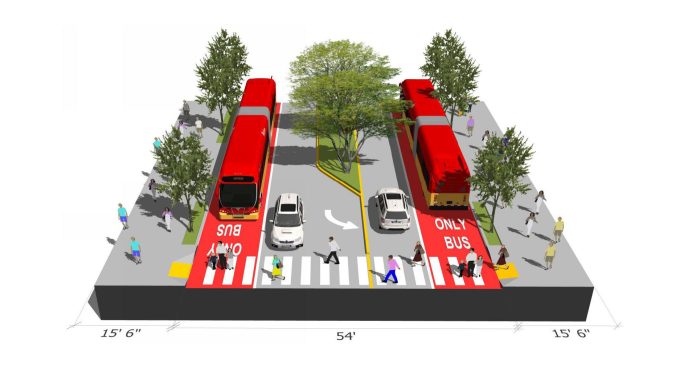
When a pedestrian is struck and killed in your neighborhood you are at a loss for words. When it has happened five times in a calendar year, you are in a crisis. Safety for pedestrians along Aurora Avenue is out of control. Seattle residents want to fix it, but the Seattle Department of Transportation (SDOT) has said they don’t have the budget. And even with Mayor Jenny Durkan’s announcement of a Vision Zero initiative, SDOT said it will begin developing an Aurora Avenue redesign plan… starting in 2021. Not exactly a rapid timeline.
On November 29th four pedestrians were struck by a motorist and two were killed. We are left wondering how we fix this road. Aurora Avenue is not a road that should be dangerous. It’s an at grade highway with historically thriving storefronts and walkability that generated its beginning.
But then Henry Ford mass produced the automobile.
As this destructive element became increasingly available to every family in America, Seattle ripped up miles of streetcar networks that competed with the urban highway. And our city’s attitude shifted (as did America’s). No longer was it about the pedestrian, but rather, about how fast you can get from point A to point B without stopping for one second.
I can’t stand the current condition of Aurora. I see its potential and wants it to succeed. King County Metro’s RapidRide E Line, Route 5, Route 26, and Route 28 have more than 33,000 in combined daily transit ridership–all relying on this wretched road. It can be upgraded to rail and should have been the spine of Sound Transit 2’s north expansion, but I digress. There are plenty of six-lane roads that are safer, and better designed than Aurora. There are plenty of rights-of-way just as wide as Aurora and nobody dies, business thrives, and the traffic modes vary.

Vancouver, British Columbia is famous for rejecting every elevated highway proposal that crossed their planning department’s desk in the 1960s. But they should also be famous for what they did to their Aurora Avenues.
The Mount Pleasant neighborhood is bisected or adjacent to three roads that are like Aurora (BC Highway 7, BC Highway 1A, and Quebec Street). You see, these roads were just as problematic as Aurora. They catered to automobile traffic, pass-through drivers, and rarely featured a cyclist or pedestrian.
But today? Mount Pleasant is one of the most thriving neighborhoods in the entire city. It features businesses, small retail, commercial office, residential density, walkability, and the highest bus ridership in the United States and Canada. To give you perspective, the E Line, which travels on Aurora, carries 18,000 daily riders which ranks number one in Washington state for ridership. The 99 B Line, which runs along BC Highway 7 in Vancouver, carries 58,000 daily riders. That’s three times the ridership as the E Line and almost double our total transit ridership of combined bus routes on Aurora.
So, how can that be?
Besides the obvious fact that the density along their corridor caters to high ridership, Vancouver cleans up on frequency and safety. Every 100 seconds a bus arrives along this line. The E Line’s best performance is every four minutes. And when it comes to pedestrian safety, Mount Pleasant’s highways feature landscape buffers and wide sidewalks.

The Washington State Department of Transportation just completed the repaving of Aurora Avenue from Downtown Seattle to Shoreline. SDOT could have jumped on the opportunity to alter the design. Instead, SDOT is placing attention on projects like an unnecessary full replacement of the Magnolia Bridge, a project that will carry far less daily traffic.

Aurora Avenue is a public right-of-way. That means we own it and we can change it. What we are missing is a partnership between the city and state transit departments working together to provide a road that doesn’t starve other modes of transportation to prioritize cars. That means the WSDOT and SDOT working together. Not just on cosmetic changes, but on removing a general purpose lane in each direction to either widen sidewalks, add transit lanes, add trees and greenery, or a combination thereof.

No matter how it happens, by toll or closure or natural disaster, every inconvenience for drivers causes car traffic to decrease. And maybe that’s what Aurora Avenue needs. Instead of enticing people to zip through our city 10 miles per hour over the speed limit, maybe we need to cut out some danger and add some safety.
Drivers adapt. If you build a seven-lane highway catering to the car, people will drive and speed. If you toll a tunnel downtown, 30% of the drivers will stop using it. When the state built the SR-520 bridge it carried 103,000 daily drivers. When they tolled it, that figure dropped by 33%.
A removal of one lane in each direction would mean we can dedicate a safe and comfortable space for people to walk or bike and force drivers to slow down. It gives space for a landscape buffer. It offers the space to build a rail line. It offers us a chance to say enough is enough, fix it, and make it a place everyone feels safe.

The other attitude that needs to change is policing. People think Aurora’s safety record is due to everything but cars. Seattle police see sex crime as the problem and are going to great lengths and wasted efforts to criminalize sex workers, even catching their own force in the process. Sex work shouldn’t be criminalized–it forces the trade underground where it’s most dangerous and wastes policing hours. The real menace on Aurora is rampant speeding, distracted driving, impaired driving, and aggressive motorist behavior.
Aurora’s biggest danger is the automobile. The most common crime is committed by a driver. Here’s a look back at some of the crimes of 2019:
- November 29th: Aurora Ave N between N 39th St and N 40th St (two pedestrian fatalities);
- October 21st: Aurora Ave N and N 98th St (pedestrian fatality);
- September 16th: Aurora Ave N between N 67th St and N 68th St (pedestrian serious injury);
- August 14th: Aurora Ave N between N 85th St and N 86th S (pedestrian fatality).
- June 15th: Aurora Ave N between N 95th St and N 96th St (pedestrian serious injury); and
- May 14th: Aurora Ave N between Halladay Street and Raye Street (pedestrian fatality).
These people have had their lives cut short or significantly altered by walking on Aurora. They were caught in a system that puts their needs last.
It’s time to fix Aurora. It’s time to make a difference. Let’s make Aurora what we want. Let’s make Aurora safe.

Ryan DiRaimo
Ryan DiRaimo is a resident of the Aurora Licton-Springs Urban Village and board member of the neighborhood group ALUV. He works at an architecture firm downtown and seeks to leave a positive urban impact on Seattle and the surrounding metro. He advocates for more housing, safer streets, and mass transit infrastructure and hopes to see a city someday that is less reliant on the car.

